Gallery Network
7 Questions for Artist Callum Innes on the Appeal of His ‘Off-Kilter’ Paintings
Callum's first solo show in Los Angeles in over three decades is on view now at Sean Kelly.
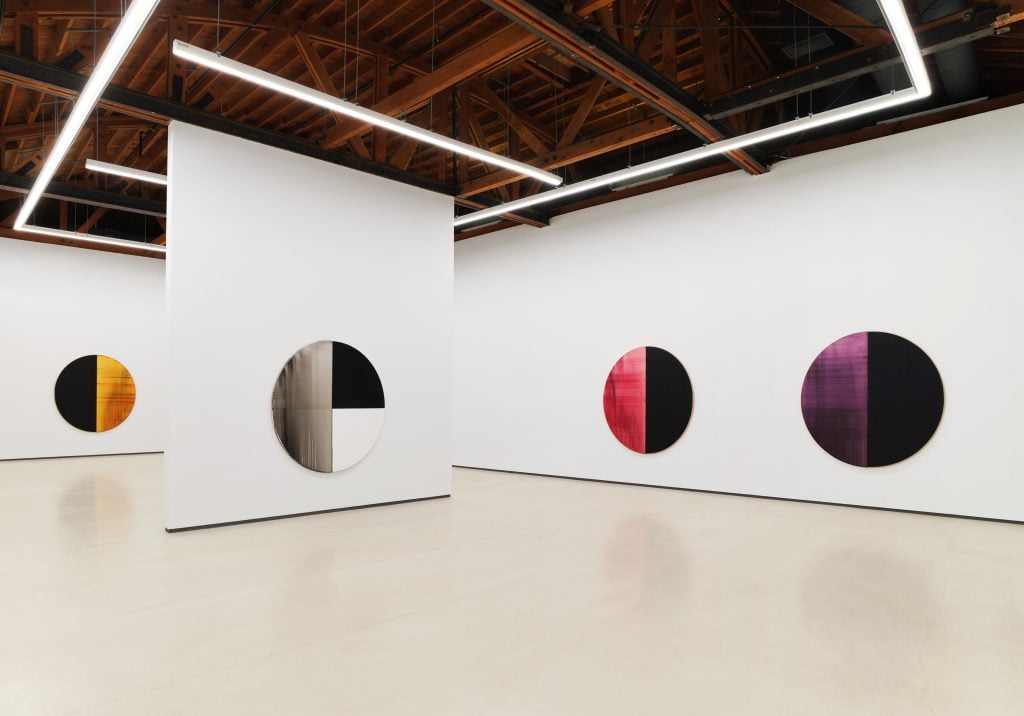
Callum's first solo show in Los Angeles in over three decades is on view now at Sean Kelly.

Artnet Gallery Network

Scottish artist Callum Innes (b. 1962) is best known for his large monochromatic and gradient color field paintings, often filling precisely delineated planes of the work’s support. While historically Innes’s work has been primarily canvas, it is increasingly employing the use of wood. Innes’s work has been exhibited extensively around the world, but this month marks a special return—to Los Angeles.
On view through May 4, 2024, the artist’s solo exhibition “Turn” is on view at Sean Kelly Los Angeles. Featuring recent “Tondo” works alongside pieces from some of his most celebrated series, including “Exposed Paintings” and “Split Paintings,” the exhibition highlights some of the more profound evolutions in his practice. The show is also accompanied by a new publication produced by the gallery featuring an essay by art historian Éric de Chassey.
We reached out to Innes to learn more about the significance of a show in L.A., as well as what led him to more fully explore the possibilities of the tondo painting.
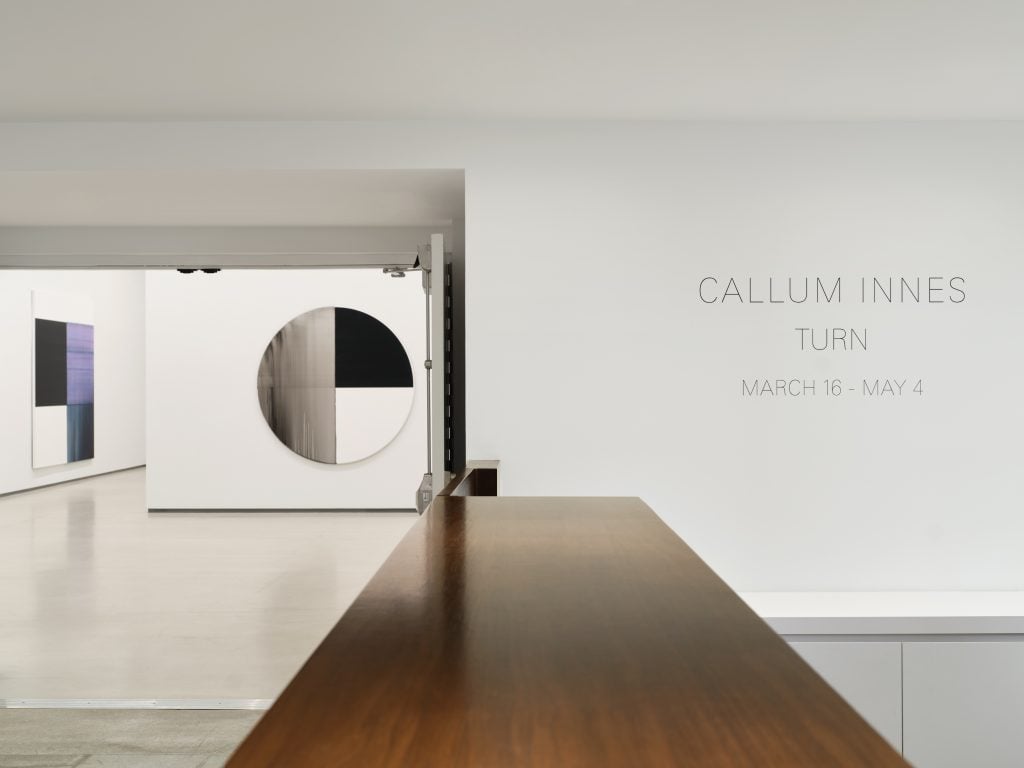
Installation view of “Callum Innes: Turn” (2024). Photo: Brica Wilcox. Courtesy of Sean Kelly New York / Los Angeles.
Your solo show with Sean Kelly is your first in Los Angeles in more than 30 years. What are some of the themes or ideas behind this body of work?
It is my first show in 31 years… it’s a reintroduction of my work to the public in L.A. There’s a new body of work which consists of the tondos, which is shown in conjunction with the paintings I’m known for, the “Exposed Paintings” and the “Split Paintings,” which have changed again. It’s not really a comprehensive introduction to the bodies of work which haven’t been shown in L.A., it’s just maybe more recent work.
Can you tell us about what inspired you to take up the format of the tondo paintings in the first place?
After two years of Covid in Oslo working on my own, not in the studio in Edinburgh, Sotheby’s asked me if I would take part in an auction for a charity in Scotland for deprived children. They asked if I would consider painting on a cask end of a barrel of whiskey and I rather blithely said yes.
When I got back to Edinburgh, for the first time after Covid, there were five cask barrels in the studio that had been delivered. I couldn’t work on them because they were 30 years old. They were very moist from the whiskey and my assistants were complaining about the smell. I had a friend who made a facsimile of a cask end, I started to enjoy the challenge of working on a tondo. The challenge of working on a circle.
With the way the work had been physically changing in Oslo over the previous two years, the way that light had affected the paintings and the structure, it became quite challenging working on something that I wasn’t familiar with, and I enjoyed the process. One thing led to another, and before I really realized what I’d done, I’d ordered a company in London to make me several larger tondos as the cask end was quite small. It’s a new element completely, they are very physical. They’re almost sculptural too, and I’m working on wood, which I’ve never done before, and compositionally it’s been quite challenging.
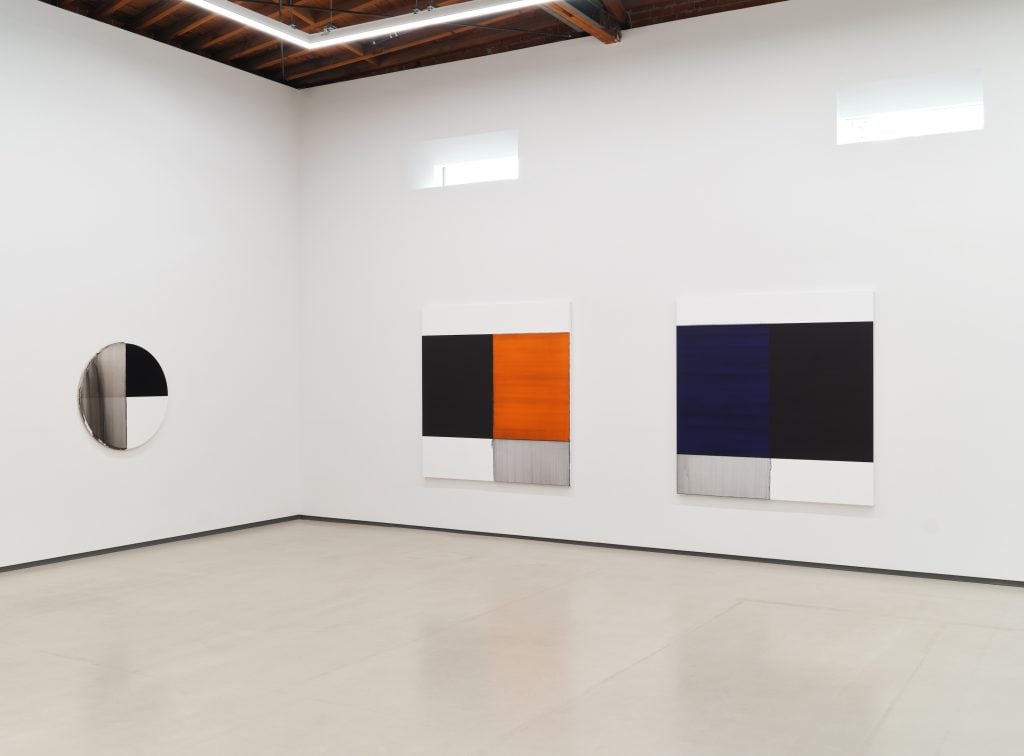
Installation view of “Callum Innes: Turn” (2024). Photo: Brica Wilcox. Courtesy of Sean Kelly New York / Los Angeles.
In what ways, if at all, does your approach to a tondo composition differ from the way you approach a rectangular composition?
My approach hasn’t changed. You must solve the composition regardless of what the format is. What has changed is the way I paint. With a rectangular or square painting, you have a distinctive edge. With a tondo you have a curve or a turn. When the brush hits the edge, it reacts in a very different way.
What has been interesting is how I’ve solved the compositions. With the “Exposed Paintings,” I haven’t left the space at the top. It’s been taken right out of the surface or the format. Because there’s a slight bevel on the exposed edge of the tondo, the painting expands into the space in a way that it previously hasn’t done in a rectangle. You have to bear that all in mind when you’re making a painting, but they still have the same characteristics of failure.
In looking at your practice overall, do you approach a new work with a fully fleshed-out plan of what you are going to do or is it more intuitive and spontaneous?
What I’ve been doing in the studio recently is, every morning, making 10 to 15 sketchbooks. I work out what I’m going to do with the “Tondos” and the paintings in my head, and in these books beforehand, the kind of mark I want to make. Then I’ll make a small thumbnail sketch of where I want the composition to be, how I want the proportion to work.
I set up all these rules… and then I ignore them. My work works because it’s off-kilter. It’s a good Scottish word, it means it’s not quite right. When it’s not quite right, it works. If it was mannered and if it was considered too far, if I measured it all up and taped it up in a certain way—it would be dead and have no life and have no history.
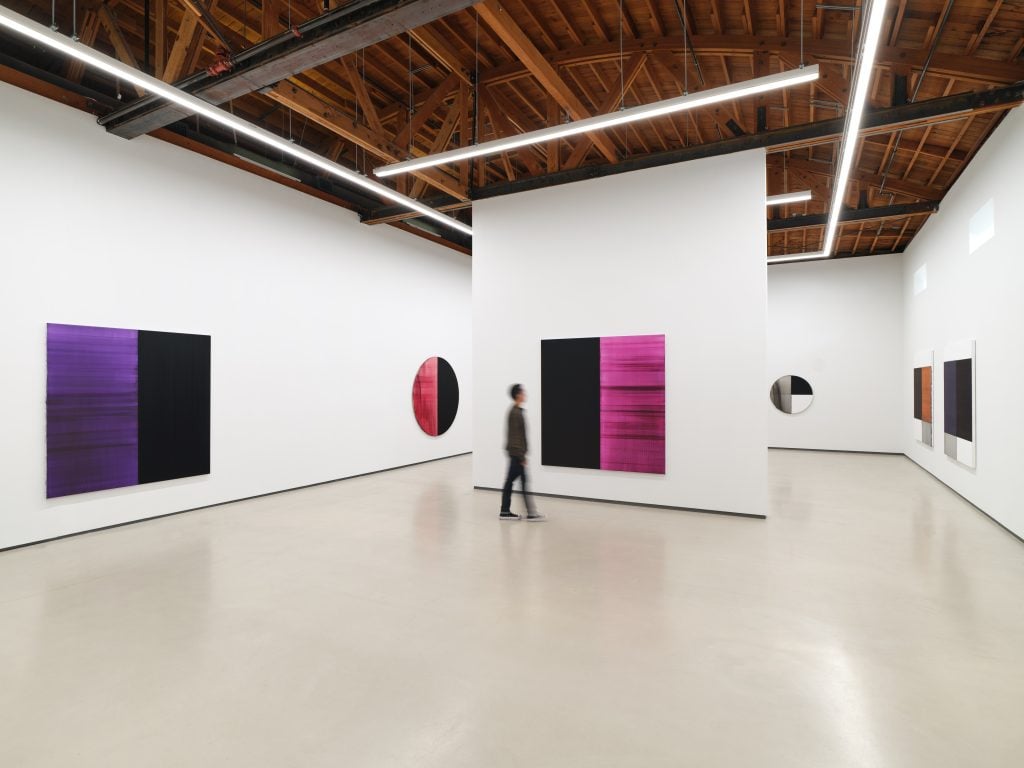
Installation view of “Callum Innes: Turn” (2024). Photo: Brica Wilcox. Courtesy of Sean Kelly New York / Los Angeles.
The exhibition at Sean Kelly is accompanied by a new publication including views of past exhibitions. Do you ever derive new inspiration from looking back over the course of your career?
The publication has years of recent exhibitions which have included “Tondo” paintings, not older exhibitions. The great thing about doing a book, is that as an artist, you almost have this fear of repetition, and repetition is very important in my work, but not the same in each work each time, and things change ultimately bit by bit very slowly and you work within a language. But what reassures me when you make a book, is in the process when you print out all the images from shows and you lay them out on the floor, there is a realization of where and how your work has moved over the years. It’s only when you’re confronted with this that maybe you gain new inspiration and insight. I enjoy looking back and I never shut any series down completely. In this show, there’s a “Shellac Painting” and I haven’t made those for 15 years. I wish I had made them 15 years ago on the tondo, not in the rectangle and it’s far more appropriate for them to be on the tondo. It feels right for the paintings. So actually, looking back through the work, you can almost find inspiration in the things that you can take forward.
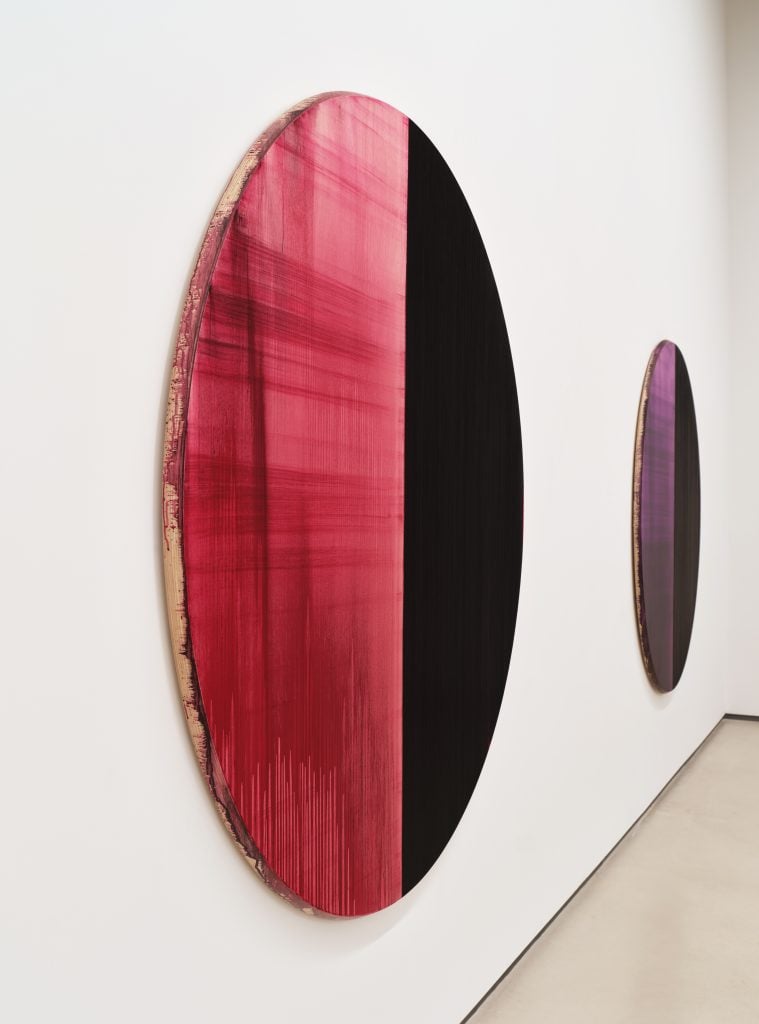
Installation view of “Callum Innes: Turn” (2024). Photo: Brica Wilcox. Courtesy of Sean Kelly New York / Los Angeles.
In the same vein, reflecting on the evolution of your practice, what are some themes or sources of inspiration that have remained consistent or alternatively diverged the most as shown in your recent work?
Well, the main theme is that everything has been a white lie for many years, and I mean that in the best possible sense. I still see the paintings as being inherently figurative, although they’re not. I see the figuration through the way you approach the painting physically, but although the paintings are imbued with my mark-making, physicality, and emotional state, there is a sense of intrinsic history in the paintings. But really there’s many themes that run through my work, from landscape to light to space, which is constant. If you look at the big “Exposed Painting,” the translucency of that painting and the light it gives off is like water. It has a depth and landscape is very important to me. I don’t title the paintings as such as that would shut them down for the viewer. But the things that are important to me in life are all the things that are important to everybody. Whether it be landscape or the emotional connection you have to the world or to light to death or whatever. It’s very hard to explain what an artist does every day. A very spurious way of doing it—and I’ve done it before with a book—where I sat down with a colleague and just wrote down everything that came into my head in that day: the wine I was drinking last night, the color of the wine, the book I was reading the previous day, or Pablo Neruda, or what was in the Guardian that day.
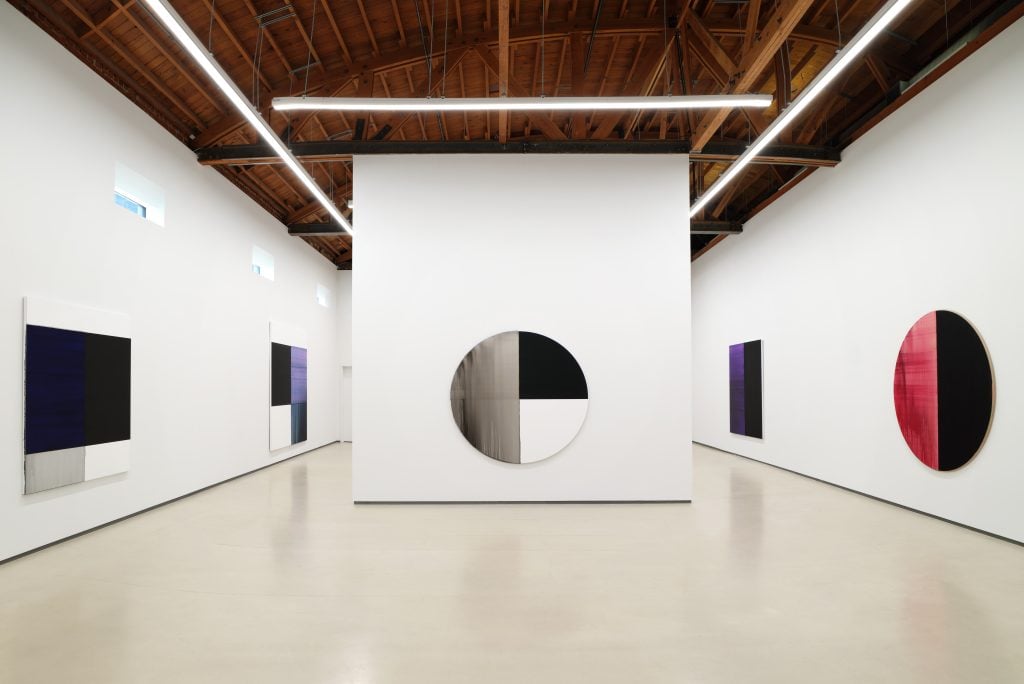
Installation view of “Callum Innes: Turn” (2024). Photo: Brica Wilcox. Courtesy of Sean Kelly New York / Los Angeles.
Are you currently working on any new projects or have plans on what you will work on next?
Currently, I have a solo exhibition on view at Kode Bergen in Norway. The second part of the exhibition is a permanent light piece on the museum’s facade which has three panels that will change in sequence and that coincides with the exhibition there. I also have quite a few commercial gallery shows in the future, but the big project really has been the “Tondos” over the last couple of years. The process of working between Oslo and Edinburgh has changed everything quite a bit because I make works and I don’t see them for six or seven weeks. When I come back, and see them again, it’s changed the way I edit the work and the way I approach the work. It’s very strange working on something and then you don’t see it for a while. I think it’s helped the work. I think it’s changed the work. It’s made the work slightly more rigorous. It was always rigorous, but in my head, it’s made it more rigorous.
“Callum Innes: Turn” is on view at Sean Kelly, Los Angeles, through May 4, 2024.